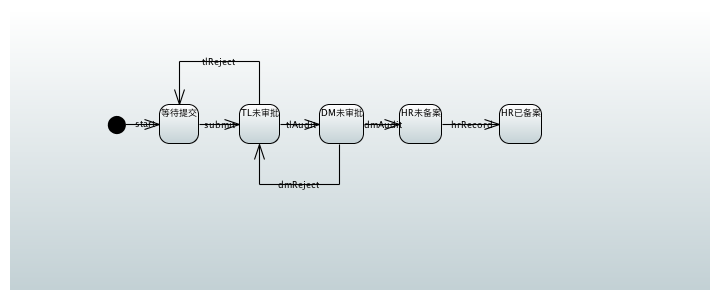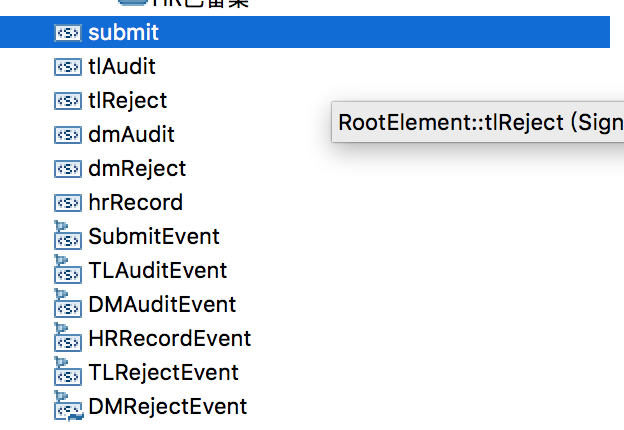Spring StateMachine(2) UML状态图支持
版权声明:本文为博主原创文章,未经博主允许不得转载。 https://blog.csdn.net/kmyhy/article/details/84787556
还是刚才的以二级审批请假流程为例。
绘制流程
首先创建 Papyrus 项目,选择 StateMachine 模板,绘制流程图如下:

然后创建 6 个 signal event 和与之绑定的 signal :

注意,在 Papyrus 图中,除了 State (状态) 和 Transition(迁移)之外,还有 Signal 和 Signal Event 的概念,它们对应于 StateMachine 中的 Event(事件)。其中 Signal 就是事件的名字(字符串常量)。
将 Tansition 和 Signal Event 绑定(设置 trigger)。
加载 uml 状态图
将 Papyrus 生成的 uml 文件放到 idea 的 resource 目录。
因为 State、Event 和 Transition 都定义在 UML 中了,所以 States 枚举和 Events 枚举不再需要,状态机的配置也简化了,直接从 UML 文件来加载:
@Override
public void configure(StateMachineModelConfigurer<String, String> model) throws Exception {
model
.withModel()
.factory(modelFactory());
}
@Bean
public StateMachineModelFactory<String, String> modelFactory() {
// 测试二级审批请假流程
UmlStateMachineModelFactory factory = new UmlStateMachineModelFactory(
"classpath:model.uml");
factory.setStateMachineComponentResolver(stateMachineComponentResolver());
return factory;
}
注意,这里 States 和 Events 的类型都变成了 String,毕竟在 UML 中不太好定义类型。
如果要注册 Action 或者 Guard,可以通过 Resolver 进行:
@Bean
public StateMachineComponentResolver<String, String> stateMachineComponentResolver() {
DefaultStateMachineComponentResolver<String, String> resolver = new DefaultStateMachineComponentResolver<>();
resolver.registerAction("myAction", myAction());
resolver.registerGuard("myGuard", myGuard());
return resolver;
}
public Action<String, String> myAction() {
return new Action<String, String>() {
@Override
public void execute(StateContext<String, String> context) {
}
};
}
public Guard<String, String> myGuard() {
return new Guard<String, String>() {
@Override
public boolean evaluate(StateContext<String, String> context) {
return false;
}
};
}
发送事件
跟之前一样,发送事件使用状态机的 sendEvent。只不过 Event 的类型统统是字符串,而且必须在 UML 中定义为 Signal。
private BaseResponse sendEvent(String event,String leaveId){
BaseResponse result = new BaseResponse();
if(leaveId == null || leaveId.length()==0){
result.success = false;
result.message = "leaveId 不能为空";
return result;
}
try {
// 根据业务 id 获取状态
persister.restore(stateMachine,leaveId);
result.success = stateMachine.sendEvent(event);
// 持久化状态机
if (result.success) {
persister.persist(stateMachine, leaveId);
}
JSONObject data = new JSONObject();
result.message = result.success ? "执行成功":"执行失败";
result.message = result.message + ",当前状态为:"+stateMachine.getState().getId();
data.put("leaveId",leaveId);
data.put("event",event);
data.put("state",stateMachine.getState().getId());
result.data = data;
} catch (Exception e) {
e.printStackTrace();
result.message = e.getMessage();
}finally {
stateMachine.stop();
return result;
}
}
可以看到,通过 UML 方式绘制状态机,减少了在代码中定义 Event、State 和 Transition 的过程,但 UML 中必须通过额外的元素(Signal和 Signal Event)来定义事件,在目前来说 Spring StateMachine 只支持 Papyrus 绘制的 UML 图。











![[HBLOG]公众号](https://www.liuhaihua.cn/img/qrcode_gzh.jpg)

